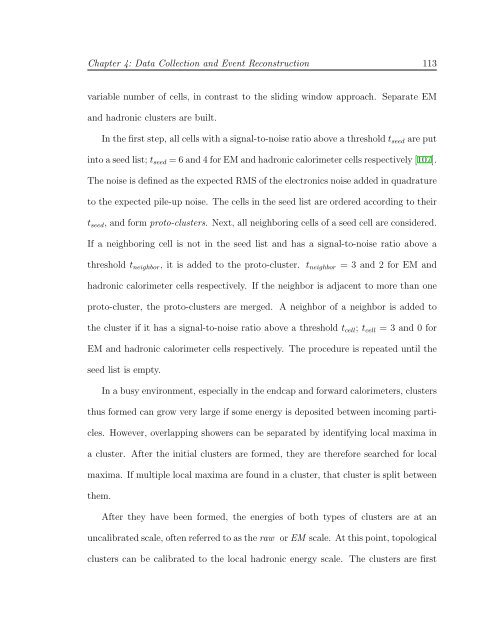Measurement of the Z boson cross-section in - Harvard University ...
Measurement of the Z boson cross-section in - Harvard University ...
Measurement of the Z boson cross-section in - Harvard University ...
You also want an ePaper? Increase the reach of your titles
YUMPU automatically turns print PDFs into web optimized ePapers that Google loves.
Chapter 4: Data Collection and Event Reconstruction 113<br />
variable number <strong>of</strong> cells, <strong>in</strong> contrast to <strong>the</strong> slid<strong>in</strong>g w<strong>in</strong>dow approach. Separate EM<br />
and hadronic clusters are built.<br />
In <strong>the</strong> first step, all cells with a signal-to-noise ratio above a threshold tseed are put<br />
<strong>in</strong>to a seed list; tseed = 6 and 4 for EM and hadronic calorimeter cells respectively [107].<br />
The noise is def<strong>in</strong>ed as <strong>the</strong> expected RMS <strong>of</strong> <strong>the</strong> electronics noise added <strong>in</strong> quadrature<br />
to <strong>the</strong> expected pile-up noise. The cells <strong>in</strong> <strong>the</strong> seed list are ordered accord<strong>in</strong>g to <strong>the</strong>ir<br />
tseed, and form proto-clusters. Next, all neighbor<strong>in</strong>g cells <strong>of</strong> a seed cell are considered.<br />
If a neighbor<strong>in</strong>g cell is not <strong>in</strong> <strong>the</strong> seed list and has a signal-to-noise ratio above a<br />
threshold tneighbor, it is added to <strong>the</strong> proto-cluster. tneighbor = 3 and 2 for EM and<br />
hadronic calorimeter cells respectively. If <strong>the</strong> neighbor is adjacent to more than one<br />
proto-cluster, <strong>the</strong> proto-clusters are merged. A neighbor <strong>of</strong> a neighbor is added to<br />
<strong>the</strong> cluster if it has a signal-to-noise ratio above a threshold tcell; tcell = 3 and 0 for<br />
EM and hadronic calorimeter cells respectively. The procedure is repeated until <strong>the</strong><br />
seed list is empty.<br />
In a busy environment, especially <strong>in</strong> <strong>the</strong> endcap and forward calorimeters, clusters<br />
thus formed can grow very large if some energy is deposited between <strong>in</strong>com<strong>in</strong>g parti-<br />
cles. However, overlapp<strong>in</strong>g showers can be separated by identify<strong>in</strong>g local maxima <strong>in</strong><br />
a cluster. After <strong>the</strong> <strong>in</strong>itial clusters are formed, <strong>the</strong>y are <strong>the</strong>refore searched for local<br />
maxima. If multiple local maxima are found <strong>in</strong> a cluster, that cluster is split between<br />
<strong>the</strong>m.<br />
After <strong>the</strong>y have been formed, <strong>the</strong> energies <strong>of</strong> both types <strong>of</strong> clusters are at an<br />
uncalibrated scale, <strong>of</strong>ten referred to as <strong>the</strong> raw or EM scale. At this po<strong>in</strong>t, topological<br />
clusters can be calibrated to <strong>the</strong> local hadronic energy scale. The clusters are first















